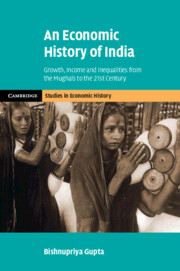Book contents
- An Economic History of India
- Cambridge Studies in Economic History
- An Economic History of India
- Copyright page
- Dedication
- Contents
- Figures
- Maps
- Tables
- Acknowledgements
- Introduction
- 1 The Decline and the Rise of the Indian Economy
- 2 Agriculture as the Engine of Growth
- 3 From Handlooms to Modern Industry and the Emergence of a Planned Economy
- 4 Origins of India’s Service Sector Advantage
- 5 Region, Income, Caste, and Gender
- 6 Colonial Development in a Comparative Perspective
- Conclusion
- References
- Index
2 - Agriculture as the Engine of Growth
Published online by Cambridge University Press: 06 February 2025
- An Economic History of India
- Cambridge Studies in Economic History
- An Economic History of India
- Copyright page
- Dedication
- Contents
- Figures
- Maps
- Tables
- Acknowledgements
- Introduction
- 1 The Decline and the Rise of the Indian Economy
- 2 Agriculture as the Engine of Growth
- 3 From Handlooms to Modern Industry and the Emergence of a Planned Economy
- 4 Origins of India’s Service Sector Advantage
- 5 Region, Income, Caste, and Gender
- 6 Colonial Development in a Comparative Perspective
- Conclusion
- References
- Index
Summary
Chapter 2 focuses the largest sector of the economy: Agriculture. The rural economy produced most of the output in Mughal India and in British India. 85 percent of the population lived in rural communities. The economic history of India has a rich narrative of regions, of introduction of new institutions and integration of the cultivators into commercial exchange of food and raw material at the regional level. This chapter brings together an overall narrative of the regions and explains why some regions prospered, while others declined. It sees the role of infrastructure as an important part of this discussion, that is, the impact of the railways and irrigation. While British investment in irrigation and new technology in agriculture was inadequate and can explain agricultural stagnation in different parts of the country, the railways played an important role in integrating markets. The chapter ends with a discussion of the building of agricultural infrastructure after independence and the Green Revolution of the 1960s and it importance in economic growth and development.
- Type
- Chapter
- Information
- An Economic History of IndiaGrowth, Income and Inequalities from the Mughals to the 21st Century, pp. 43 - 76Publisher: Cambridge University PressPrint publication year: 2025

